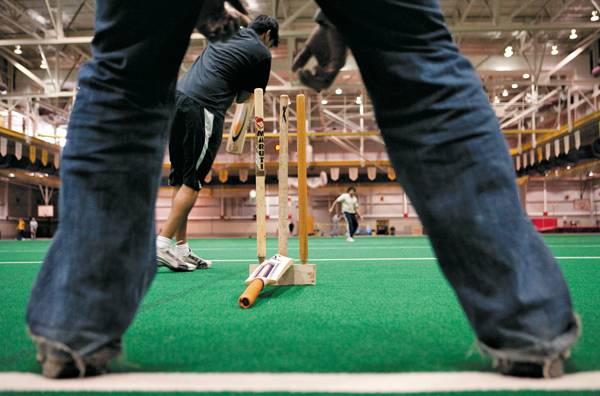CLUBS: Calling all for cricket

The ISU Cricket Club practices on Tuesday. The club practices during the winter months for its matches in the summer. Photo: David Livingston/Iowa State Daily
February 23, 2010
Like many Americans, most ISU students don’t know the first thing about cricket.
To many, it’s a confusing sport they don’t really understand, and few take the time to learn.
The ISU Cricket Club would like that to change.
“Most people [in United States] don’t know about cricket,” said Siddharth Sridhar, a second-year graduate student in computer engineering. “And most don’t know the United States has a national team, either.”
Sridhar, the club’s president, along with the rest of the students in the club, aren’t naive enough to think cricket will ever gain major popularity in the United States.
“Cricket is too long for Americans,” Sridhar said. “The game takes too long, and people can lose interest quickly.”
At Iowa State, the club competes in tournaments in an organization called the Cricket League of Iowa, where eight teams from throughout Iowa and one from Nebraska compete.
“We won at the Omaha Championship last year,” said Sujith Sukumaran, a second-year graduate student in mechanical engineering. “But we narrowly lost at the CLIA championship and finished fifth of the eight teams.”
Sridhar also said the club hosts a tournament at Iowa State each summer.
They are even going to teach Ames elementary students to play this year, he said.
Many people compare cricket to baseball.
Both are played with a bat and ball, but that is where the similarities end.
Sridhar said Cricket was invented in England and was popularized throughout the British colonies around the world.”
Cricket, has three basic formats —the oldest being nearly 200 years-old and only two of which are commonly played around the world, Sridehar said.
The most popular, he said, is called 20/20.
“In 20/20 you have two innings, where each side gets to bat only once,” Sridhar said.
“The 20 represents overs, which are basically each pitch as you would call it in baseball. You only get 20 overs in an inning, so basically 20 throws — that’s it.”
Club members only get three hours every Sunday to play at Lied Recreation Athletic Center, so they normally shorten the game.
“We usually only play eight overs, with eight players per side, too,” Sridhar said. “That way we have a chance of finishing.”
“The central premise to cricket is similar to baseball in that the goal is to score more runs than the other team,” Sridhar said.
“When a team is up to bat, each of its 10 players has a chance to come up to bat.”
“There are 10 players per team, so there are 10 outs per inning,” said Ganesan Mani, a second-year graduate in computer engineering and member of the club.
The object of the fielders, or defense, is to throw the hard leather ball they play with at three sticks behind the batter, called stumps.
If a batter swings and misses, and the ball hits the stump and that batter is out, Mani said.
‘There are always two batters up at each time. One is up to bat at one end of the pitch, and one at the other.
When the batter receiving the pitch from the bowler — similar to the pitcher in baseball — and gets a hit, the two runners sprint back and forth, collecting runs each time they cross the white line at each end.
Runners are not allowed, though, to intentionally block a ball from hitting the stump with their body.
If they do so, they are out, Mani said.
“The runners continue until the ball strikes a stump and dislodges it,” said Sharan Sethuraman, a second-year graduate student in mechanical engineering and member of the club.
“However, the ball can be caught in mid-air like in baseball. In that case, the runner is out automatically.”
But unlike in baseball, the fielders catching fly-balls aren’t allowed to wear gloves.
That right is held only by the keepers, who like a catcher in baseball, and stand behind the batter and stumps to collect the ball.
“The bowlers have two common throwing forms.
One type of bowler is a fastballer, the other is a spinner,” Sridhar said.
“The fastballer bowls just like a pitcher in baseball, only the ball cannot be above that batsmen’s waist,” Sridhar said. “Spinners bounce the ball before it gets to the batsmen, and like the name, try to put as much spin on it as possible. If you bounce it, the ball can then go above the batsmen’s waist.”
“There are some bowlers who can throw [more than] 100 mph,” Sukumaran said. “There are also some who can throw well beyond that.”
Cricket also has its own version of a home run, Sridhar said.
In cricket, if a fly ball goes over the fence, it’s worth six runs.
If it bounces over, then it’s worth four.
Unlike baseball, though, the batter is still up to bat afterward, and will continue to hit until he is called out.
Once the fielding team either gets 10 batsmen out or gets to 20 overs pitches, then the inning is over and the sides switch.
After the two innings are over, there can be a winner and loser, the teams could tie or the teams could play to a draw if the time limit is exceeded.
While Sridhar and the other club members admit that can be a lot to comprehend, they wish for anyone who wants to give cricket a try.
“It’s $15 to join for the year,” Sridhar said. “Any skill level can play. We’ll teach anyone.”






